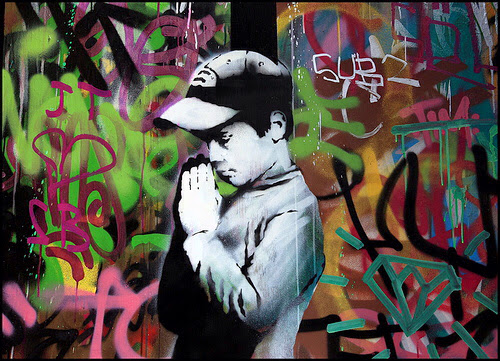As parents of three little ones, it's a rare thing to find quiet and solitude in our home. When I covet devotional time for prayer and meditation, I often feel like the Psalmist: Where can I go? If I take the wings of the morning, you are there asking me to go potty. If I descend into the depths of the basement, you are there planting a mine field of Legos. If I turn out the lights and hide in the darkness, you turn on the flash of my iPhone and claim we've constructed a fort. For even the darkness is not dark to you, the night is as bright as the day so you find joy in pushing your bedtime later and later (Psalm 139, Parent Remix).
These aren't complaints. They also are not confessions of a parent who hides from his children, for nothing could be farther from the truth. Instead, it's an honest embrace of reality. Real life is not crafted for variations of monastic prayer. But prayer is most definitely intended for real life and the chaos that comes with it.
Which brings a whole new meaning to Karl Barth's well-known statement, "to clasp our hands in prayer is the beginning of an uprising against the disorders of the world."
Prayer is one of faith's greatest mysteries. Prayer cannot be defined, explained, comprehended, defended, or perfectly performed. Yet, whether while we pace with a fussy newborn in the middle of the night, wash dishes that have piled up during the day (or week), walk the streets of Philadelphia or the market of Tegucigalpa, huddle together with forty teenagers on retreat, or sit in the silence of an empty chapel, we are invited to pray.
Prayer is a lot like graffiti, we are not always certain about the how or the why or even the who and when of our prayers. Prayer pops up all over the place, not limited by convention or sacred galleries we call sanctuaries. Prayer, much like graffiti, is beautiful because it's honest and scribbled over both the ordinary and complexity of everyday life. You could even say prayer is a secret movement of the Spirit whose petitioners and practioners do not look for public recognition rather express what is frequently buried deep within the human soul.
Jan Milič Lochman says it well, "Prayer as this inner dimension embraces and accompanies the whole polyphony of human life. In this sense all thoughts and actions that respect God and his creation are acts of prayer" (The Lord's Prayer 6).
PolyphonIc prayer includes all of the following and more:
Stillness.
Silence.
Chaos.
Gratitude.
Heartache.
Anger.
Forgiveness.
Hope.
Deliverance.
Confession.
Trust.
Strength.
Doubt.
Help.
Prayer as encompassing all the varied sounds of human experience may be why the writer of First Thessalonians challenged the faithful to "pray without ceasing" (5:16). Prayer, in the midst of life's ebbs and flows, is the on-going, steady, and centered posture of trust in the God who made us, redeems us, and sends us into the world. When we doubt, lose trust, and stray from our sacred center, prayer is the Spirit's metronome that gently tugs at the heart and draws us back again.
It could be said that prayer is the never ending melody that shapes our whole life and interaction in and for the world. So when we pray without ceasing to a God who has promised always to hear our prayers we begin to see ourselves, others, and the world around us through the same lens of the God who made all things and the Jesus who suffered, died, and rose again for the whole world, including you and I.
Prayer must also ultimately push us towards action. We don't pray passively. We pray expectantly. We pray for healing, justice, forgiveness, comfort, generosity, peace, and for all the wrongs, even our worst of enemies, to be made right and good again. And when we pray these kind of prayers, we begin to shape our lives so they echo the sounds and move in rhythm with what we have prayed for and to whom we have prayed.
"Christians pray to God that he will cause his righteousness to appear and dwell on a new earth under a new heaven. Meanwhile they act in accordance with their prayer as people who are responsible for the rule of human righteousness, that is, for the preservation and renewal, the deepening and extending, of the divinely ordained human safeguards of human rights, human freedom, and human peace on earth" (Karl Barth, The Christian Life 205).
We confess this because prayer is not only about asking for things from God. Prayer is also about God asking for a response from us. Prayer reminds us we are God's partners and co-laborers in ushering in the kingdom, God's dreams for a new and transformed world.
There's a whole lot more that can be said about prayer. But prayer is meant to be engaged not by a talking (read: blogging) head, but by the collection of the faithful called the church.
Actually, prayer is meant to be humbly and mysteriously sprayed with quiet utterances all over the disordered world. These are the very beginnings of subtle uprisings that draw others towards the love, justice, generosity, and peace characteristic of the new heaven and new earth already here and still to come.
So may our prayers never cease, even when we cannot find quiet or solitude. Actually, may we pray all the more in the midst of life's chaos and confusion. That's what God intended anyway.
*Image above is street art in London by the mysterious Banksy. The boy is praying in front of what is supposed to be a stained glass window crafted over graffiti on a building. The irony is awesome.

